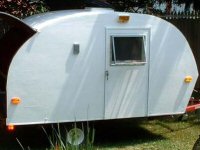Hello all. I figure it is time to consult the brain-trust that is this forum with a question: I am interested in a 12v system for things like a dome light, porch lights, a CO2 detector and a portable DVD player.
What I need is some help in choosing panel wattage and a battery. I have been compiling a list of energy requirements, and I think I have them nailed down pretty well:
2 LED porch lights: 1 amp each, maybe a few hours a day.
1 LED dome light: 1 amp, maybe a few hours a day.
DVD player: 3 amps @ 9.8v, maybe 2 hours a day.
12v CO2 detector: 0.6 amp, 24 hour draw.
So my current calculations indicate a 26.4 amp hour draw on the battery, per day. Let's call is an even 30 for simplicity sake (I don't see it going over 30, for almost any reason).
Now, I figure I can cut about 7 amp hours by shutting down the carbon monoxide detector via master switch during the day and turn it back on in the evening. So on second thought, lets call it 20 amp hours. That is, if I understand this correctly?
So assuming my calculations are correct, what kind (watts) of panel should I be looking for?
Thanks in advance.
Solar Design Time
8 posts
• Page 1 of 1
Lets look at an 85 watt panel to start with, say this one from eBay:
UL Solar Linky
The peak current output is 4.84 amps . A conservative calculation for the daily amp-hr harvest of a flat panel is:
peak current*5 hours/day full sun*80% typical efficiency=daily amp-hrs
4.84*5*0.8~20 amp-hrs.
You can increase your harvest by 20% by tilting your panel. You can get 10-20% over that by moving the panel during the day to track the sun.
26 amp-hrs in a night is a lot, I think you're over estimating the LED draw. You should be able to get LEDs that draw a half to a quarter of what you've estimated.
Bruce
P.S. A group 24 deep cycle battery has around 85 amp-hr capacity. That should carry you through a couple of rainy days.
UL Solar Linky
The peak current output is 4.84 amps . A conservative calculation for the daily amp-hr harvest of a flat panel is:
peak current*5 hours/day full sun*80% typical efficiency=daily amp-hrs
4.84*5*0.8~20 amp-hrs.
You can increase your harvest by 20% by tilting your panel. You can get 10-20% over that by moving the panel during the day to track the sun.
26 amp-hrs in a night is a lot, I think you're over estimating the LED draw. You should be able to get LEDs that draw a half to a quarter of what you've estimated.
Bruce
P.S. A group 24 deep cycle battery has around 85 amp-hr capacity. That should carry you through a couple of rainy days.
2009 6.5'X11' TTT - Boxcar
All it takes is a speck of faith and a few kilowatts of sweat and grace.

Boxcar Build
aVANger Build
All it takes is a speck of faith and a few kilowatts of sweat and grace.

Boxcar Build
aVANger Build
-

bdosborn - Donating Member
- Posts: 5595
- Images: 806
- Joined: Wed May 05, 2004 11:10 pm
- Location: CO, Littleton

